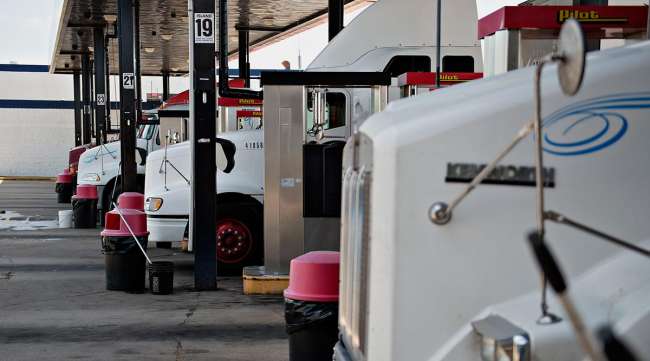Oil Prices Slide, Diesel Falls 3.5¢ to $2.489 a Gallon

The U.S. average retail price of diesel dropped 3.5 cents to $2.489 a gallon, while the stubborn glut of crude caused oil prices to tumble to about $43 a barrel — a range last seen in early August — and into a bear market, experts said.
It was diesel’s third consecutive weekly decline. Diesel prices have dipped by 8.2 cents a gallon since May 29.
Diesel now costs 6.3 cents more than it did a year ago, when the price was $2.426 a gallon, the Department of Energy said June 19.
Each regional price for trucking’s main fuel also fell.
The U.S. average price for regular gasoline sank 4.8 cents to $2.318 a gallon. The cost is 3.5 cents more than it was a year ago, DOE’s Energy Information Administration said.
Weekly gasoline prices fell in all regions, EIA said.
The average price for gasoline has dropped 9.6 cents a gallon in the past two weeks.
West Texas Intermediate crude futures on the New York Mercantile Exchange closed at $43.23 per barrel June 20, compared with $50.73 a month ago on May 22.
In a bear market, prices drop by 20%, compared with the high over the past 52 weeks, experts said. WTI’s highest closing price over the past year was $54.45 on Feb. 23.
One fleet executive based in Billings, Mont., said fuel management was wrapped up in the industry’s biggest issue — attracting and retaining drivers.
“The truck stop chains offer a rewards and incentive program for the driver. The more that they focus on the driver, the more the driver comes to us and says, ‘I want to stop here instead of there.’ That forces us to review where we are going to buy our gallons,” Jay Foley, president of Diversified Transfer & Storage, told Transport Topics.
The company has about 90 trucks and does less-than-truckload temperature-sensitive foods shipments across the United States and western Canada. It has warehouse operations in Billings, Denver and Salt Lake City. Diversified uses about 100,000 gallons of diesel a month and buys 15,000 to 20,000 gallons in Montana, he said.
Foley said he welcomes Love’s Travel Stops & Country Stores recent expansion into the Big Sky state 45 miles east of Billings on Interstate 90 because it will increase competition and add 70 parking spaces. Diversified has been a Love’s customer for more than 10 years, he said.
“One of the biggest problems for drivers is the issue of parking. We have never had enough parking, so any time we can get an additional truck stop with additional parking is beneficial to our industry,” Foley said.
Meanwhile, the Atlantic hurricane season — which began June 1 and runs through Nov. 30 — is less than three weeks old, yet it’s already threatening the energy-rich Gulf of Mexico coastline, Bloomberg News reported June 20.
Tropical systems in the Gulf of Mexico often grab the notice of energy traders because the Texas and Louisiana coastline is home to offshore rigs and platforms accounting for about 17% of U.S. crude oil output and 4.1% of natural gas production. Bloomberg said. They can lead to the evacuation of nonessential personnel from rigs and platforms, cause power outages and also disrupt shipping, such as at the Port of Houston.
In the meantime, U.S. crude inventories fell by 2.5 million barrels from the week ending June 9, at 509.1 million barrels, EIA said.
Soft demand and the global oil glut continue.
“We’re awash in oil, and the biggest issue you have is global demand as a whole that’s just slowly improving, but not at the pace needed to get the rebalancing,” Mark Watkins, the Park City, Utah-based regional investment manager at U.S. Bank Wealth Management, which oversees $142 billion in assets, told Bloomberg News.
Looking ahead, Diversified’s Foley doesn’t know when fuel prices may rise to catch up with the cost of oil production.
“What you hear is prices need to be at $60 a barrel for [producers] to make money, but there seems to be an oversupply currently of oil and not enough demand,” he said.
Electrification of vehicles, mandated increases in mpg and alternative fuels eventually will shrink demand for diesel even more, he added.
“So it is going to be interesting to see what happens with oil. It is all about supply and demand,” Foley said. “We see it every day.”
The weekly U.S. rig count reached 933 during the week of June 19, up six from the week before and 509 more than a year earlier, oil field services company Baker Hughes Inc. reported.
Houston-based Baker Hughes ranks No. 14 on the Transport Topics Top 100 list of the largest private carriers in North America.
Bloomberg News contributed to this report.




